 Sideways over a gap
Sideways over a gap Sideways over a gap Sideways over a gap |
| Sometimes, there isn't enough room to balance on the rear wheel, in front of the gap. But if you can place the bike parallel to the gap, then you may as well start from there. You can launch a pedal hop sideways, either landing parallel, or turning during the pedal kick to land as if you had started balancing on the back wheel, frontally. It is easier to jump on the opposite side of your good foot (jump on the left if you are right-footed) |
| The neat thing about this is that you don't need to balance for ever on the rear wheel... | ||
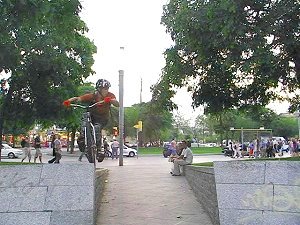 |
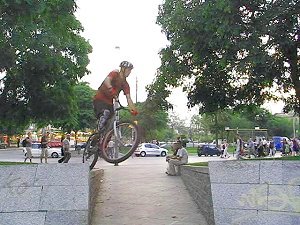 | |
| 1° Prepare for the jump extension, with your good foot ready to kick on the pedal, and the body on the side of the gap. | 2° Start kicking in your good pedal while aiming at your landing mark, pulling the bars in the direction of the gap to cross. | |
 |
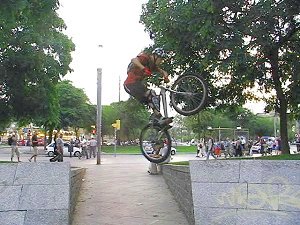 | |
| 3° Full extension sideways to finish off the pedal kick. The bike has nearly turned 90 degrees and leans towards the gap, ready for a frontal landing. | 4° Once in the air, pull the bike up in front of you to transfer it on the other side. Full brakes on when the rear wheel touches the edge. | |
| Usually the rear wheel touches first, but if you push down on the bars, you can land both wheels at once for a better grip (on rocky areas).See the move in a video | ||
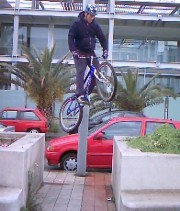 parallel hop / slight turn | practice: This move is very different to the very small side hops that are used for repositioning the bike. Instead of just lifting the bike by some small bounces, you really need to kick in your good-foot pedal, end up on the rear wheel in full extension and carry on the jump by lifting the bike with you. The difficult part is if you must land parallel, without being dragged sideways afterward, by your inertia. You must counter-balance this by landing the bike inclinated towards the opposite direction of the move. That way, the inertia just bring you back in balance, with the bike straight. |
| Turning 90° for landing Actually in most cases, it is easier to turn 90° during the pedal kick, and land directly on the rear wheel, in the direction of the move. Most of the turn impulsion takes place during take off, with the rear wheel still touching the ground. Turning 90° guarantees a stable landing. |
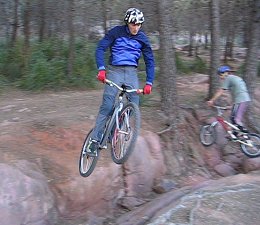 90° turn for landing |